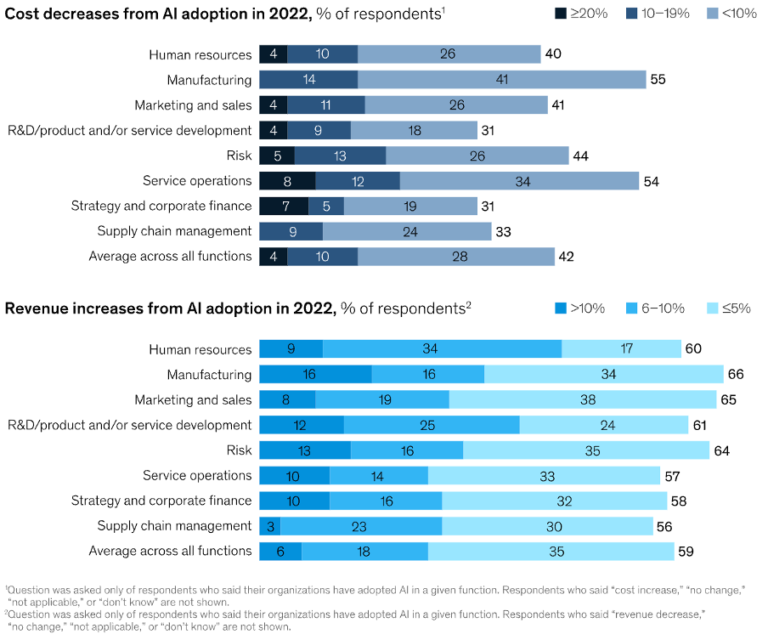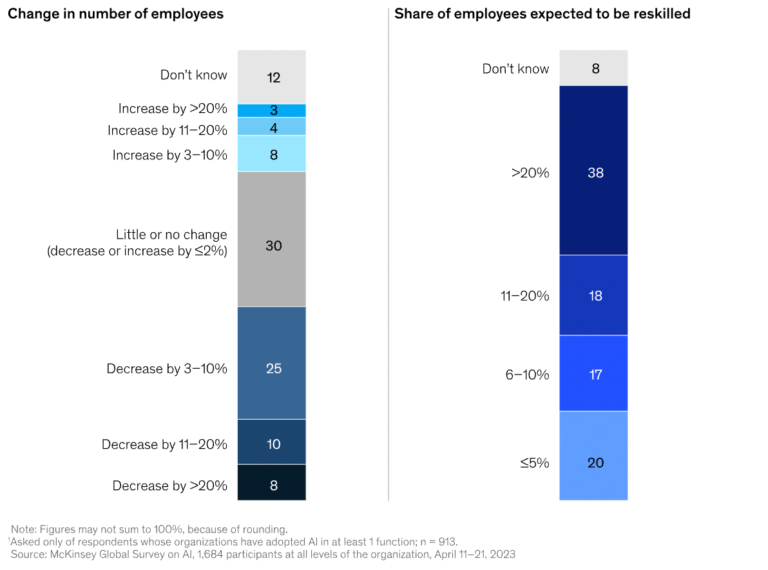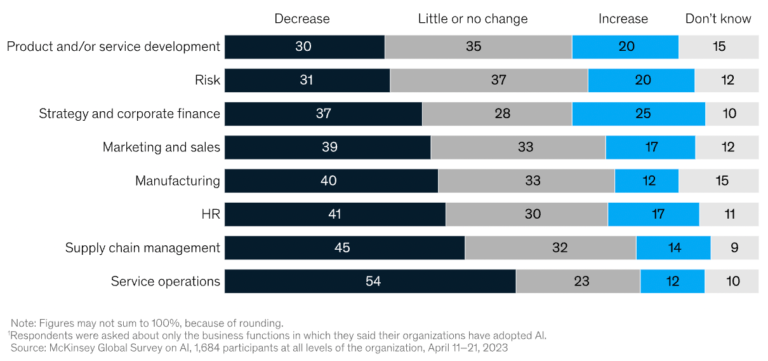In today’s tech-reliant age, the saying “Data is the new gold” or the widely echoed statement “Generative artificial intelligence (Gen AI) will change the world” couldn’t be more apparent. To truly grasp the profound impact of AI, one must take a closer look at the countless earnings calls where generative AI’s transformative potential takes center stage. Amid the hype and jargon, it is evident that Gen AI has the power to revolutionize our society in the near future. This article intends to demystify Gen AI’s impact on modern work by focusing on hard data regarding its corporate adoption.
Gen AI’s Adoption So Far
Across the globe, companies are becoming increasingly aware of the necessity to reshape their business model for the new era of Gen AI. This shift is not confined solely to the IT sector; it is permeating various industries such as finance, healthcare and even law. Many companies are realizing that Gen AI is a matter of sink or swim. Companies are at a crossroads to either embrace Gen AI and unlock promising growth potential or resist change and risk falling behind. According to a recent study by S&P Global (2023), which surveyed over 1500 organizations worldwide, approximately 69% of them have at least one Gen AI project in production, and 28% report having reached enterprise scale with them.
McKinsey’s “The State of AI in 2023: Generative AI’s Breakout Year” report (2023) provided further key insights by surveying 1684 employees across all levels of organizations. Their studies showed that:
- In terms of sectors, The ‘Technology, Media and Telecom’ industries used Gen AI the most, followed by ‘Financial Services’
- Averaged across industries, 3 in 4 employees have experimented with Gen AI, with senior managers leading the way. Increasingly, mid-level managers are at the forefront of using AI outside of work, suggesting its multipurpose potential.
- When it comes to office locations, employees from China are embracing AI most enthusiastically, closely followed by Europe and North America.
The rest of the report focuses further on companies that have implemented Gen AI in at least one business function. For starters, it sheds some light on how its use differs across departments:
- 14% of ‘Marketing and Sales’ departments use it, mainly in crafting text documents, personalized marketing and summarizing text documents.
- 13% of ‘Product and service development’ departments employ it, primarily for identifying customer needs, drafting technical documents, and creating new product designs.
- 10% of Service Operations departments utilize it, mainly for tasks like using chatbots and forecasting service trends or anomalies.
Given its impressive track record, in terms of cost reduction and revenue growth (Figure 1), such generative AI implementation has clear economic benefits. Thereby, the ‘Manufacturing’ and ‘Service Operations’ departments have proven themselves to contain the most cost-cutting potential. At the same time, ‘R&D/product and or service development’ as well as ‘Strategy and corporate finance’ seem least receptive to such measures. On the other hand, in terms of revenue growth opportunities, the landscape looks significantly more evened out across departments with on average 60% of businesses standing to benefit.

Workforce Effects
Such stark changes in cost structures as well as revenue models will inevitably switch up the dynamics within businesses. One of its most important aspects is the impact it will have on the workforce and consequently people’s livelihoods. About 1 in 3 respondents expect that more than 20% of employees will require retraining in the next three years. Moreover, more than half project this number to lie in the range of 5% to 20%. To put it in more concrete terms, this means that the vast majority of employees currently believe that between every fifth to every twentieth worker will need to switch their job skills by 2026. On the other hand, 43% of respondents anticipate that their company headcount will decrease between 3% to more than 20%. Despite this, less than 1 in 3 respondents maintain that little or no change will result in the new age of Gen AI (McKinsey, 2023).

Finally, McKinsey’s report (2023) concluded with an illustration showcasing how these workforce changes are presumed to differ across company departments in the next three years (Figure 3). Currently, ‘Service Operations’ and ‘Supply Chain Management’ seem to be the most affected which may be tied to their heavy administrative load. As for the departments least affected, ‘Product and/or service development’ as well as ‘Risk’ stand out potentially due to the inherent unpredictability characterized in their work. Hence, it appears that business functions that have the most algorithmic operations are positioned to be most strongly influenced by Gen AI, for better or for worse.

Gen AI’s Potential
At the same time, Gen AI holds enormous promise to enhance productivity not only by automating repetitive tasks but also by acting as a de facto personal assistant. Microsoft’s (2023) article ‘Will AI fix work?’, which is based on a survey of 31,000 employees across 31 countries, highlights in what regards Gen AI is sought after in the workplace (Figure 4).

These aspirations may soon become a reality, with a recent study from LinkedIn’s Economic Graph Research Institute (2023) suggesting that up to 84% of US LinkedIn users could automate a quarter of their tasks with Gen AI. Business leaders share this excitement, as an online survey of 300 global executives reveals (KPMG, 2023). Thereby, 77% consider Gen AI the most impactful current technology and 71% planning to implement their first solution within two years. IT/Tech and Operations departments are the primary areas for deployment, closely followed by Marketing and Sales, Customer, and Product Development/R&D.
This implementation not only promises cost savings but also new revenue streams and innovative offerings. Particularly, the latter seems to be of primary importance as 69% of managers focus on revenue drivers while only 31% concentrate on cost drivers (KPMG, 2023). McKinsey’s report (2023) underscores this, highlighting that 2 in 3 companies have revenue growth opportunities as their top objective. Meanwhile “AI high performers” (e.g. organizations in which at least 20% of EBIT was derived from AI use in 2022) are even more inclined to use Gen AI for revenue growth. To summarize, even though revenue drivers are predominating across the board, this emphasis seems to only increase as businesses scale their AI operations.
Challenges Along the Way
The journey toward Gen AI implementation, however, is not without its challenges. The aforementioned “AI high performers” cite “Models and Tools” as the most formidable challenge, whereas respondents with less experience identify “Strategy” as their primary hurdle. This suggests that as businesses progress in their implementation, they face more technological barriers than organizational ones (McKinsey, 2023).
Furthermore, KPMG’s report (2023) shows that managerial challenges and talent acquisition barriers are the primary impediments. Technical infrastructure concerns such as identifying appropriate Gen AI models and insufficient technology infrastructure seem to be less common. Regarding the latter, the S&P Global report (2023) explores these infrastructure-related challenges further and concludes that Data management represents the most significant barrier. The primary issue seems to be the incompatibility between conventional legacy data architecture and the requirements of AI/ML applications. Data sourcing, standardization, model training, and practical testing further compound the challenges of data science.
In the face of these obstacles, most businesses still seem to be ill-equipped to take them on, with only 1% of business executives claiming they possess the necessary in-house skills, while 63% intend to hire new talent or train existing staff (KPMG, 2023). Hence, an ever-increasing demand for workers with technical backgrounds and more specifically people with AI skills.
Risks to Watch Out For
Some may argue that these persisting challenges are for the best because neither corporations nor our society as a whole seems to be prepared yet to manage Gen AI responsibly. Undoubtedly, with its transformative power comes great responsibility. International organizations are grappling with how best to regulate this technology. Meanwhile, business leaders are starting to gain first-hand experience of the pitfalls employing Gen AI can entail. In this context, about half of McKinsey’s (2023) survey respondents cite “Inaccuracy,” “Cybersecurity,” and “IP-infringement,” as the greatest of risks. This aligns with the KPMG (2023) survey, where business executives identify “Cybersecurity” and “Data privacy” as the most significant hazards. On the other hand, “IP issues” and “Inaccuracy” are considered less problematic.
Another concerning statistic is that, in terms of risk mitigation, only 6% of companies have established a dedicated team for evaluating risk and implementing risk mitigation strategies. Most other firms are either in the early stages of addressing this concern or have yet to start. Furthermore, McKinsey (2023) indicates that approximately only about one-third of companies are actively involved in managing their risk. The discrepancy between these proportions and the amount of firms already playing with AI tools is cause for concern, to say the least.
A Call to Caution
The rise of Gen AI promises great benefits for employees and executives. Repetitive tasks can be automated, boosting efficiency, profitability, and productivity. However, significant challenges and unforeseen risks are also part of the implementation journey. As scandals such as the production of a deepfake video of Volodymyr Zelenskyy reveal, AI can distort the truth, cause widespread political confusion and precipitate ripple-effects that endanger people’s lives in the real world. Particularly for businesses in the tech field, who are now learning to wield the power of Gen AI, it is paramount to recognize this fact. Only then can the further proliferation of misinformation be prevented and our data privacy, cybersecurity, and intellectual property be safeguarded.
Ending with a more hopeful outlook, if we can navigate this Gen AI frontier responsibly and stay alert to its pitfalls, each of us can benefit from its transformative potential while preserving integrity and security. We can use this new technology to bring about a rising tide that lifts all boats, heralding a new age of economic prosperity. At the same time, we can equally as well lose control and be walloped by a flood of uncontrollable magnitude. The choice is ours.
Patrick Hanley
Author
Mark Bermeo
Editor

One Response
I like the hopeful and analytical approach to the topic, but what I appreciate are the cautions and risks addressed regarding AI. Its important to have holistic and thought out risk analysis when creating such disruptive technologies. So, I’d like to give many thanks to the author for doing this. Great read !